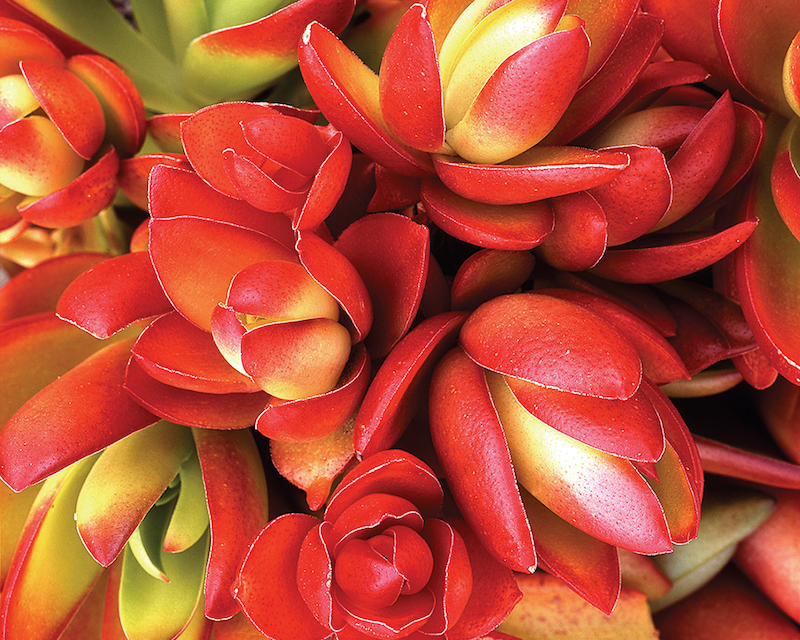Growing Crassula
Crassula is a genus of plants native to South Africa. This highly variable genus includes popular houseplants such as jade plants (Crassula ovata), silver dollar plants (Crassula arborescens), and string of buttons (Crassula perforata). This diverse group of succulents contains plants that grow from just a few inches tall to several feet high, ranging from tiny, herbaceous ground covers to tall, woody shrubs. Crassulas have glossy green, fleshy leaves and clusters of star-shaped flowers in hues of pink and white. Although they are slow growing, crassulas are easy indoor plants to take care of.

Crassula Sunlight Requirements
Crassula grows best in bright indirect light. Place your crassula near a southern-facing window, but be sure that it is far enough from the window that it will not receive direct afternoon sun. Crassula can tolerate shorter periods of direct morning sun. It will not perform well in low light levels. Crassula requires bright, consistent light to remain vibrant and healthy. Less light will result in etiolation (stretching for the light) with dull-colored foliage.
Planting Crassula
Crassula should be planted in a sturdy pot with excellent drainage. Size up an inch larger than the plant’s root ball. Use a well-drained soil mix with neutral to slightly acidic pH. A succulent mix or regular potting mix with perlite or sand added are good choices for crassula. Avoid using soils that are peat heavy, as they will retain too much moisture for your crassula. This plant should be repotted every 2 years during the spring growing season.

Watering Crassula
As with many succulents, crassulas have mechanisms to survive drought and do not need to be watered often. The amount of water needed differs depending on the species, but generally watering every 1-2 weeks during spring and summer is enough, sometimes less. During fall and winter, watering can be reduced to just once or twice a month. Overwatering can be avoided by soaking crassula plants in a container or sink filled with water. Lower the pot into the water so that all of the soil is submerged. Allow it to sit in the water until the soil is evenly moist, usually indicated by bubbling from the pot’s drainage holes. Lift up the plant and allow it to drain completely. Let your crassula dry out between watering. Crassula is native to dry environments and prefers low humidity.
Fertilizing Crassula
Crassulas do not require regular fertilization. These plants are adapted to dry, rocky environments where they thrive in poor soils. If desired, fertilizer can still be applied just once a year in either spring or summer. Use a low-strength fertilizer formulated for succulents. A higher-strength fertilizer can be diluted to half the recommended strength. Do not fertilize at all in fall or winter during their dormant period.
Common Crassula Problems
Crassula leaves turn yellow and drop due to stress, often from problems with watering, light, or temperature. Crassula requires temperatures between 65-80° for best growth. Colder temperatures will result in leaf damage and drop. It is also normal for older leaves to fall off of the plant to divert energy into newer leaves. Crassulas are fairly pest resistant, but may get spider mites, aphids, and mealybugs. Check for yellowing leaves and sooty mold, which are signs of pests. Treat with neem oil as needed. Root rot from overwatering is another problem faced by crassulas. Remove any squishy, brown roots and stems, and propagate healthy leaves and stems in fresh, dry soil. If your crassula is not blooming, be sure that it is receiving adequate light. Blooming in crassula is initiated by exposure to long nights, usually in winter or spring. Reduce watering and temperature during this time. Only mature crassula plants will bloom.

Propagating Crassula
Crassulas can be propagated with leaf and stem cuttings. For leaf cuttings, select a single, mature leaf from a healthy plant. For stem cuttings, use sterile scissors or a knife to take a 3” cutting with 1-2 nodes. Allow your leaf or stem cuttings to callus over by placing them in a warm, dry spot for a week. Dip the end of the leaf or stem in rooting hormone for best results. Prepare pots or flats with moist, well-drained potting soil. Once the cuttings are ready, place them into the soil, about an inch deep. Do not water right away – only when the soil dries out. Place them in bright, indirect light and let roots develop. Repot when needed.
Growing Crassula Outdoors
Crassula can be grown as a perennial outdoors in zones 10-12. In colder zones, it can be moved outside in a pot during the warmer months. Be sure to acclimate it to changing outdoor temperatures and light. While it prefers warmer temperatures, many species of crassula can handle cooler temperatures and even a light frost. Place your crassula in a location where it will receive morning sun and afternoon shade. Water your crassula lightly, and more if conditions are dry or sunny. Crassulas will not need to be watered often if planted in the ground or if conditions are humid.
 |
Lauren Youngcourt - Published 03-02-2023 |
